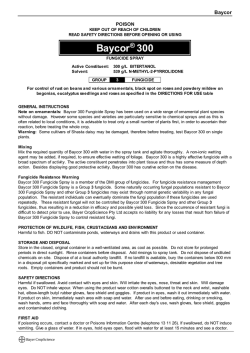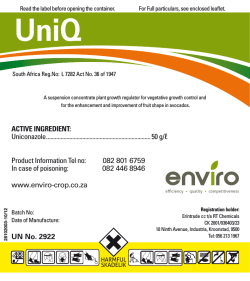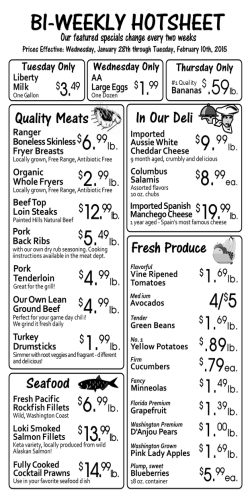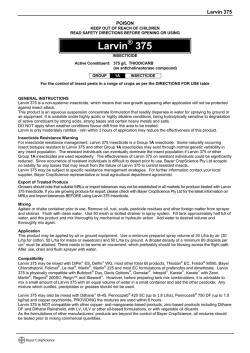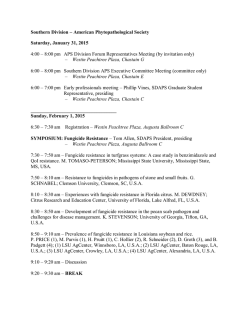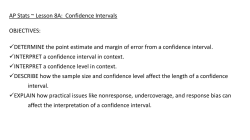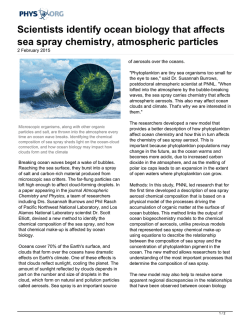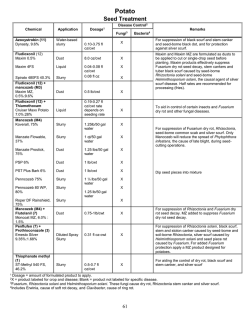
Product Label ( PDF, 90 kb)
GROUP U8 FUNGICIDE VIVANDO® SC FUNGICIDE SUSPENSION CONCENTRATE For use on Fruiting Vegetables, Grapes, Pome Fruit, Cherry Subgroup 12-09A, Cucurbits Group 9, Peach Subgroup 12-09B and Hops COMMERCIAL (AGRICULTURAL) GUARANTEE: Metrafenone ………… 300 g/L Contains 1,2-benzisothiazolin-3-one at 0.048% as a preservative REGISTRATION NO. 29765 PEST CONTROL PRODUCTS ACT CAUTION – EYE IRRITANT READ THE LABEL AND ATTACHED BROCHURE BEFORE USING KEEP OUT OF REACH OF CHILDREN IN CASE OF EMERGENCY ENDANGERING LIFE OR PROPERTY INVOLVING THIS PRODUCT, CALL DAY OR NIGHT, 1-800-454-2673 NET CONTENTS: 0.1 L - Bulk BASF Canada Inc. 100 Milverton Drive 5th Floor Mississauga, Ontario L5R 4H1 1-877-371-2273 VIVANDO is a registered trade-mark of BASF SE, used with permission by BASF Canada Inc. GENERAL INFORMATION VIVANDO SC Fungicide is formulated as a suspension concentrate (SC). VIVANDO SC Fungicide provides control of powdery mildew on fruiting vegetables, grapes, pome fruit, cherry Subgroup 12-09A, cucurbits Group 9, peach Subgroup 12-09B and hops. VIVANDO SC Fungicide provides optimum disease control when applied in a regularly scheduled protective fungicide program and when used in a spray program that rotates fungicides with different modes of action. Mode of Action Metrafenone, the active ingredient in VIVANDO SC Fungicide, affects several stages in the infection process of the powdery mildew pathogen. It has a different mode of action than that of other fungicides registered for use against powdery mildew. VIVANDO SC Fungicide affects development and growth processes of the powdery mildew pathogen. It inhibits spore germination, infection and subsequent mycelial growth. It also reduces sporulation by preventing normal development of conidiophores and conidia. PRECAUTIONS 1. KEEP OUT OF REACH OF CHILDREN. 2. May irritate eyes. Avoid contact with eyes. 3. Wash thoroughly after handling and before eating, drinking or smoking. 4. Wear long sleeved shirt, long pants, chemical resistant gloves, socks and footwear during mixing/loading, application, clean-up and repair. 5. If clothing becomes contaminated, remove and wash separately from household laundry before reuse. 6. Clean spray equipment thoroughly after use. 7. Apply only when the potential for drift to areas of human habitation or areas of human activity such as houses, cottages, schools and recreational areas is minimal. Take into consideration wind speed, wind direction, temperature, application equipment and sprayer settings. 8. If this pest control product is to be used on a commodity that may be exported to the U.S. and you require information on acceptable residue levels in the U.S., visit CropLife Canada’s web site at www.croplife.ca. FIRST AID If swallowed: Call a poison control centre or doctor immediately for treatment advice. Have person sip a glass of water if able to swallow. Do not induce vomiting unless told to do so by a poison control centre or doctor. Do not give anything by mouth to an unconscious person. 2 If on skin or clothing: Take off contaminated clothing. Rinse skin immediately with plenty of water for 15–20 minutes. Call a poison control centre or doctor for treatment advice. If inhaled: Move person to fresh air. If person is not breathing, call 911 or an ambulance, then give artificial respiration, preferably by mouth-to-mouth, if possible. Call a poison control centre or doctor for further treatment advice. If in eyes: Hold eye open and rinse slowly and gently with water for 15–20 minutes. Remove contact lenses, if present, after the first 5 minutes, then continue rinsing eye. Call a poison control centre or doctor for treatment advice. Take container, label or product name and Pest Control Product Registration Number with you when seeking medical attention. TOXICOLOGICAL INFORMATION The patient should be treated symptomatically. DIRECTIONS FOR USE Apply recommended rates of VIVANDO SC Fungicide as instructed in the following crop specific application rate and timing table. Apply VIVANDO SC Fungicide with ground equipment. Equipment should be checked frequently for proper calibration. A plant-back interval of 30 days is required for all crops not listed on the registered label. As this product is not registered for the control of pests in aquatic systems, DO NOT use to control aquatic pests. DO NOT contaminate irrigation or drinking water supplies or aquatic habitats by cleaning of equipment or disposal of wastes. Field sprayer application DO NOT apply during periods of dead calm. Avoid application of this product when winds are gusty. DO NOT apply with spray droplets smaller than the American Society of Agricultural Engineers (ASAE S572.1) medium classification. Boom height must be 60 cm or less above the crop or ground. Airblast application DO NOT apply during periods of dead calm. Avoid application of this product when winds are gusty. DO NOT direct spray above plants to be treated. Turn off outward pointing nozzles at row ends and outer rows. DO NOT apply when wind speed is greater than 16 km/h at the application site as measured outside of the treatment area on the upwind side. DO NOT apply by air. Buffer zones Use of the following spray methods or equipment DO NOT require a buffer zone: hand-held or backpack sprayer and spot treatment. 3 The buffer zones specified in the table below are required between the point of direct application and the closest downwind edge of sensitive terrestrial habitats (such as grasslands, forested areas, shelter belts, woodlots, hedgerows, riparian areas and shrublands), sensitive freshwater habitats (such as lakes, rivers, sloughs, ponds, prairie potholes, creeks, marshes, streams, reservoirs and wetlands) and estuarine/marine habitats. Buffer Zones (metres) Required for the Protection of: Method of application Crop Freshwater Habitat of Depths: Estuarine/Marine Habitats of Depths: Less than 1m Greater than 1m Less than 1m Greater than 1m Terrestrial habitat Field sprayer Crop Group 9 (cucurbits), fruiting vegetables 1 0 1 1 1 Airblast Grapes Early growth stage 2 0 2 0 1 Late growth stage 1 0 1 0 1 Early growth stage 3 0 3 1 2 Late growth stage 2 0 2 1 1 Early growth stage 2 0 2 1 2 Late growth stage 1 0 1 1 1 Pome fruit Hops, cherry Subgroup 12-09A, peach Subgroup 12-09B For tank mixes, consult the labels of the tank-mix partners and observe the largest (most restrictive) buffer zone of the products involved in the tank mixture and apply using the coarsest spray (ASAE) category indicated on the labels for those tank mix partners. The buffer zones for this product can be modified based on weather conditions and spray equipment configuration by accessing the Buffer Zone Calculator on the Pest Management Regulatory Agency web site. 4 Grapes Application Rate and Timing Table Crops Grapes Target Disease Powdery mildew (Uncinula necator) L product/ha Maximum Number of Applications Last Application Days to Harvest 0.750 6 14 Application directions For control of grape powdery mildew, begin applications of VIVANDO SC Fungicide at bud break prior to onset of disease. Apply VIVANDO SC Fungicide at either 14 or 21 days application interval. Use shorter interval if there are conditions conducive to high disease pressure. Under conditions of very rapid growth, use the shorter application interval to ensure new growth is adequately protected. Do not apply more than 2 sequential applications of VIVANDO SC Fungicide before alternating to at least one application of a fungicide with a different mode of action. Do not apply more than 4.5 L of product per hectare per season. The minimum interval between sprays is 14 days. Do not enter or allow worker entry during the restricted entry interval (REI) of 4 days to perform girdling or cane turning activities. Do not enter or allow worker entry during the restricted entry interval (REI) of 12 hours for all other post-application activities. 5 Pome Fruit Group Application Rate and Timing Table Crops Pome Fruit Group Apple Asian pear Azarole Crabapple Mayhaw Medlar Pear Quince Quince, Chinese Quince, Japanese Tejocote Target Disease Powdery mildew (Podosphaera leucotricha ) Rate per Application (L/ha) Maximum Number of Applications 0.75 - 1.12 3 Maximum Product Rate per Season (L/ha) 3.36 Last Application Days to Harvest 7 Application directions For control of Powdery mildew begin applications of VIVANDO SC Fungicide preventatively and continue on a 7 to 14 day interval. Use the higher rate and shorter interval when disease pressure is high. Resistance Management To limit the potential for development of resistance, do not make more than three (3) applications per season. Do not make more than two (2) sequential applications before alternating to a labeled fungicide with a different mode of action. Do not enter or allow worker entry during the restricted entry interval (REI) of 12 hours for all other postapplication activities. Fruiting Vegetables Rate and Timing Table Crops Fruiting vegetables* Target Disease Rate per Application (L/ha) Maximum Number of Applications Powdery mildew (Leveillula taurica, Oidium neolycoperisici , Erysiphe polyphaga) 0.75 - 1.12 3 Maximum Product Rate per Season (L/ha) 3.36 Last Application Days to Harvest 7 Application directions For control of powdery mildew begin applications of VIVANDO SC preventatively and continue on a 7 to 14 day interval. Use the higher rate and shorter interval when disease pressure is high. 6 Resistance Management To limit the potential for development of resistance, do not make more than three (3) applications per season. Do not make more than two (2) sequential applications before alternating to a labeled fungicide with a different mode of action. Do not enter or allow worker entry during the restricted entry interval (REI) of 12 hours for all other postapplication activities. *African eggplant, bush tomato, currant tomato, eggplant, garden huckleberry, goji berry, groundcherry, martynia, okra, pea eggplant, pepino, bell pepper, nonbell pepper, roselle, scarlet eggplant, sunberry, tomatillo, tomato, and cultivars, varieties and hybrids of these commodities. Crop Subgroup 12-09A: Cherry Subgroup and Crop Subgroup 12-09B: Peach Subgroup - Application Rate and Timing Table Crops Cherry Subgroup 12-09A Cherry, black Cherry, nanking Cherry, sweet Cherry, tart Cultivars, varieties, and/or hybrids of these Target Disease Powdery mildew (Podosphaera clandestina) L product/ha Maximum number per season Last Application Days to Harvest 2 7 0.750 - 1.12 Peach Subgroup 12-09B Nectarine Peach Cultivars, varieties, and/or hybrids of these Application directions For control of powdery mildew, begin applications of VIVANDO SC Fungicide prior to onset of disease. Apply VIVANDO SC Fungicide at 14 - 21 days application interval. Use shorter interval if there are conditions conducive to high disease pressure. Under conditions of very rapid growth, use the shorter application interval to ensure new growth is adequately protected. A non-ionic surfactant (NIS) may be added to VIVANDO SC Fungicide to improve performance. Use according to the adjuvant label. Do not apply more than 2.24 L of product per hectare per season. Do not enter or allow worker entry into treated areas during the restricted-entry interval (REI) of 12 hours. 7 Crop Group 9: Cucurbits Application Rate and Timing Table Crops Crop Subgroup 9 Cucurbits* Target Disease Powdery mildew (Podosphaera xanthii, Erysiphe cichoracearum) L product/ha Maximum number per season 0.750-1.12 3 Last Application Days to Harvest 0 Application directions For control of powdery mildew, begin applications of VIVANDO SC Fungicide prior to onset of disease. Apply VIVANDO SC Fungicide at 7 – 14 days application interval. Use shorter interval if there are conditions conducive to high disease pressure. Under conditions of very rapid growth, use the shorter application interval to ensure new growth is adequately protected. Do not apply more than 2 sequential applications of VIVANDO SC Fungicide before alternating to at least one application of a fungicide with a different mode of action. Do not apply more than 3.36 L of product per hectare per season. A non-ionic surfactant (NIS) may be added to VIVANDO SC Fungicide to improve performance. Use according to the adjuvant label. Do not enter or allow worker entry into treated areas during the restricted-entry interval (REI) of 12 hours. *Cucurbit vegetables, group 9 Chayote, Chinese waxgourd, Citron melon, Cucumber, Gherkin, Pumpkin, Watermelon; Edible gourd (hechima, hyotan, cucuzza, Chinese okra); Momordica spp. (balsam apple, balsam pear, bitter melon, Chinese cucumber); Muskmelon (cantaloupe, casaba, crenshaw melon, golden pershaw, melon, honeydew melon, honey balls, mango melon, Persian melon, pineapple melon, Santa Claus melon, snake melon); Summer squash (crookneck squash, scallop squash, straightneck squash, vegetable marrow, zucchini); Winter squash (butternut squash, calabaza, hubbard squash, acorn squash, spaghetti squash) 8 Hops Application Rate and Timing Table Crops Hops Target Disease Suppression of Powdery mildew (Podospaera macularis) L product/ha Maximum number per season Last Application Days to Harvest 0.750 - 1.12 2 14 Application directions For suppression of powdery mildew, begin applications of VIVANDO SC Fungicide prior to onset of disease. Apply VIVANDO SC Fungicide at a 14 day application interval. Under conditions of very rapid growth, ensure new growth is adequately protected. A non-ionic surfactant (NIS) may be added to VIVANDO SC Fungicide to improve performance. Use according to the adjuvant label. Do not apply more than 2.24 L of product per hectare per season. Do not enter or allow worker entry into treated areas during the restricted-entry interval (REI) of 12 hours. APPLICATION METHODS Ground application Apply VIVANDO SC Fungicide at rates listed in the Application Rate and Timing Table above (crop specific) when conditions are favourable for disease development. Use a minimum water volume to ensure thorough coverage of foliage. Consult nozzle manufacturer’s recommendations for spray pressures for specific nozzles. MIXING 1. Clean spray tank following sprayer clean-up recommendations on the label of the product applied previously. 2. Fill the spray tank one-half full of water and start agitation. 3. Add the required amount of VIVANDO SC Fungicide to the tank. 4. Continue agitation while filling the remainder of the spray tank. 5. After use, clean the spray tank. RESISTANCE-MANAGEMENT RECOMMENDATIONS Please note that VIVANDO SC Fungicide contains a Group U8 fungicide. Any fungal population may contain individuals naturally resistant to VIVANDO SC Fungicide and other Group U8 fungicides. A gradual or total loss of pest control may occur over time if these fungicides are used repeatedly in the same fields. Other resistance mechanisms that are not linked to site of 9 action but are specific for individual chemicals, such as enhanced metabolism, may also exist. Appropriate resistance-management strategies should be followed. To delay fungicide resistance: • Adhere to the label instructions regarding the use of VIVANDO SC Fungicide or other Group U8 fungicides. DO NOT apply more than two (2) sequential applications of VIVANDO SC Fungicide before alternating to at least one application of a fungicide with different mode of action other than Group U8. • VIVANDO SC Fungicide use should be based on an IPM program that includes scouting, historical information related to pesticide use, crop rotation and considers cultural, biological and other chemical control practices. • Monitor treated fungal populations for resistance development. • If disease continues to progress after treatment with this product, do not increase the use rate. Discontinue use of this product, and switch to another fungicide with a different target site of action, if available. • Contact your local extension specialist, or certified crop advisers for any additional pesticide resistance-management and/or IPM recommendations for specific crops and pathogens. • For further information and to report suspected resistance, contact a BASF representative at 1-877-371-2273 or at www.agsolutions.ca. ENVIRONMENTAL HAZARDS TOXIC to aquatic organisms and non-target terrestrial plants. Observe buffer zones specified under DIRECTIONS FOR USE. Metrafenone is persistent and may carryover. It is recommended that any products containing metrafenone not be used in areas treated with this product during the previous season. To reduce runoff from treated areas into aquatic habitats, avoid application to areas with a moderate to steep slope, compacted soil, or clay. Avoid application when heavy rain is forecast. Contamination of aquatic areas as a result of runoff may be reduced by including a vegetative strip between the treated area and the edge of the water body. STORAGE 1. Store in original tightly closed container. Protect from freezing. 2. Do not ship near food, feed, seed and fertilizers. 10 3. Store in cool, dry, locked, well-ventilated area without floor drain. 4. To prevent contamination, store this product away from food or feed. DISPOSAL For Recyclable Containers DO NOT reuse this container for any purpose. This is a recyclable container, and is to be disposed of at a container collection site. Contact your local distributor/dealer or municipality for the location of the nearest collection site. Before taking the container to the collection site: 1. Triple- or pressure-rinse the empty container. Add the rinsings to the spray mixture in the tank. 2. Make the empty, rinsed container unsuitable for further use. If there is no container collection site in your area, dispose of the container in accordance with provincial requirements. For Returnable Containers DO NOT reuse this container for any purpose. For disposal, this empty container may be returned to the point of purchase (distributor/dealer). For Refillable Containers For disposal, this container may be returned to the point of purchase (distributor/dealer). It must be refilled by the distributor/dealer with the same product. Do not reuse this container for any other purpose. Disposal of Unused, Unwanted Product For information on disposal of unused, unwanted product, contact the manufacturer or the provincial regulatory agency. Contact the manufacturer and the provincial regulatory agency in case of a spill, and for clean-up of spills. NOTICE TO USER This pest control product is to be used only in accordance with the directions on the label. It is an offence under the Pest Control Products Act to use this product in a way that is inconsistent with the directions on the label. The user assumes the risk to persons or property that arises from any such use of this product. 11 GROUP U8 FUNGICIDE VIVANDO® SC FUNGICIDE SUSPENSION CONCENTRATE For use on Fruiting Vegetables, Grapes, Pome Fruit, Cherry Subgroup 12-09A, Cucurbits Group 9, Peach Subgroup 12-09B and Hops COMMERCIAL (AGRICULTURAL) GUARANTEE: Metrafenone ………… 300 g/L Contains 1,2-benzisothiazolin-3-one at 0.048% as a preservative REGISTRATION NO. 29765 PEST CONTROL PRODUCTS ACT CAUTION – EYE IRRITANT READ THE LABEL AND ATTACHED BROCHURE BEFORE USING KEEP OUT OF REACH OF CHILDREN IN CASE OF EMERGENCY ENDANGERING LIFE OR PROPERTY INVOLVING THIS PRODUCT, CALL DAY OR NIGHT, 1-800-454-2673 NET CONTENTS: 0.1 L - Bulk BASF Canada Inc. 100 Milverton Drive 5th Floor Mississauga, Ontario L5R 4H1 1-877-371-2273 VIVANDO is a registered trade-mark of BASF SE, used with permission by BASF Canada Inc. PRECAUTIONS 1. KEEP OUT OF REACH OF CHILDREN. 2. May irritate eyes. Avoid contact with eyes. 3. Wash thoroughly after handling and before eating, drinking or smoking. 4. Wear long sleeved shirt, long pants, chemical resistant gloves, socks and footwear during mixing/loading, application, clean-up and repair. 5. If clothing becomes contaminated, remove and wash separately from household laundry before reuse. 6. Clean spray equipment thoroughly after use. 7. Apply only when the potential for drift to areas of human habitation or areas of human activity such as houses, cottages, schools and recreational areas is minimal. Take into consideration wind speed, wind direction, temperature, application equipment and sprayer settings. 8. If this pest control product is to be used on a commodity that may be exported to the U.S. and you require information on acceptable residue levels in the U.S., visit CropLife Canada’s web site at www.croplife.ca. FIRST AID If swallowed: Call a poison control centre or doctor immediately for treatment advice. Have person sip a glass of water if able to swallow. Do not induce vomiting unless told to do so by a poison control centre or doctor. Do not give anything by mouth to an unconscious person. If on skin or clothing: Take off contaminated clothing. Rinse skin immediately with plenty of water for 15–20 minutes. Call a poison control centre or doctor for treatment advice. If inhaled: Move person to fresh air. If person is not breathing, call 911 or an ambulance, then give artificial respiration, preferably by mouth-to-mouth, if possible. Call a poison control centre or doctor for further treatment advice. If in eyes: Hold eye open and rinse slowly and gently with water for 15–20 minutes. Remove contact lenses, if present, after the first 5 minutes, then continue rinsing eye. Call a poison control centre or doctor for treatment advice. Take container, label or product name and Pest Control Product Registration Number with you when seeking medical attention. 2 TOXICOLOGICAL INFORMATION The patient should be treated symptomatically. ENVIRONMENTAL HAZARDS TOXIC to aquatic organisms and non-target terrestrial plants. Observe buffer zones specified under DIRECTIONS FOR USE. Metrafenone is persistent and may carryover. It is recommended that any products containing metrafenone not be used in areas treated with this product during the previous season. To reduce runoff from treated areas into aquatic habitats, avoid application to areas with a moderate to steep slope, compacted soil, or clay. Avoid application when heavy rain is forecast. Contamination of aquatic areas as a result of runoff may be reduced by including a vegetative strip between the treated area and the edge of the water body. STORAGE 1. Store in original tightly closed container. Protect from freezing. 2. Do not ship near food, feed, seed and fertilizers. 3. Store in cool, dry, locked, well-ventilated area without floor drain. 4. To prevent contamination, store this product away from food or feed. DISPOSAL For Recyclable Containers DO NOT reuse this container for any purpose. This is a recyclable container, and is to be disposed of at a container collection site. Contact your local distributor/dealer or municipality for the location of the nearest collection site. Before taking the container to the collection site: 1. Triple- or pressure-rinse the empty container. Add the rinsings to the spray mixture in the tank. 2. Make the empty, rinsed container unsuitable for further use. If there is no container collection site in your area, dispose of the container in accordance with provincial requirements. 3 For Returnable Containers DO NOT reuse this container for any purpose. For disposal, this empty container may be returned to the point of purchase (distributor/dealer). For Refillable Containers For disposal, this container may be returned to the point of purchase (distributor/dealer). It must be refilled by the distributor/dealer with the same product. Do not reuse this container for any other purpose. Disposal of Unused, Unwanted Product For information on disposal of unused, unwanted product, contact the manufacturer or the provincial regulatory agency. Contact the manufacturer and the provincial regulatory agency in case of a spill, and for clean-up of spills. NOTICE TO USER This pest control product is to be used only in accordance with the directions on the label. It is an offence under the Pest Control Products Act to use this product in a way that is inconsistent with the directions on the label. The user assumes the risk to persons or property that arises from any such use of this product. 4
© Copyright 2025
